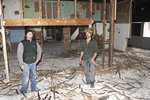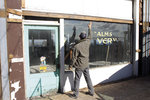Anyone with memories of the former Palms, Sea Galley or Surf restaurants may want to take a last look at one of the oldest wooden buildings on the Port Townsend waterfront before it’s gone for …
This item is available in full to subscribers.
We have recently launched a new and improved website. To continue reading, you will need to either log into your subscriber account, or purchase a new subscription.
If you had an active account on our previous website, then you have an account here. Simply reset your password to regain access to your account.
If you did not have an account on our previous website, but are a current print subscriber, click here to set up your website account.
Otherwise, click here to view your options for subscribing.
* Having trouble? Call our circulation department at 360-385-2900, or email our support.
Please log in to continue |
|


Anyone with memories of the former Palms, Sea Galley or Surf restaurants may want to take a last look at one of the oldest wooden buildings on the Port Townsend waterfront before it’s gone for good.
Hastings Development LLC is midway through demolition of the structure, which dates to the mid-1930s, and was last occupied in 2005. The interior has been gutted, with the project now shifting to roof and wall removal, which requires temporary closures of a section of Taylor Street near Union Wharf.
“The intent is to take this down stick by stick,” said Heather Dudley-Nollette, Hastings Development project manager, with no intrusion on the marine environment. “We’ve been sensitive to get the work done with the least disruption to downtown businesses and residents.”
The demolition is the first phase of a project intended to replace the building with a 62-room boutique hotel, along with rehabilitation of the adjacent three-story Hastings Building (1890), which the family’s company also owns.
There is no timetable for any new construction, which would include removal of the pilings, because financing is not yet in place, Dudley-Nollette said. A shoreline substantial development permit remains in place.
ORIGINAL SEA GALLEY
Hastings Development LLC (formerly The Hastings Estate Co.) has owned the property on which the building sits since at least 1893.
There were a lot of wooden buildings on piers along PT’s waterfront in the late 1800s, with Union Wharf – much larger than it is today – being one of the main docks for passenger and freight boat connections.
The existing structure was built in 1934 on pilings and beams that likely date to the late 1800s. During demolition last month, a copy of the Saturday Evening Post magazine dated March 23, 1935 was discovered tucked in an attic space.
A restaurant known as The Palms was in operation by the 1940s, and by the 1960s, it had become The Surf.
Steve Dowen of Seattle purchased the business in 1972 from Al and Rosemary Reierson and Tommie and George Wallace, who had owned the restaurant since 1964. Dowen reopened it as Sea Galley, and soon opened two Sea Galley restaurants in Seattle. The Sea Galley company went public in 1980, and its sales peaked in 1983. However, by 1990, hurt by an ill-fated expansion to the East Coast, many of its restaurants had been closed or sold.
Dowen, who had lost his position with the company, repurchased the Port Townsend property in late 1994 after Sea Galley entered bankruptcy. The business reopened in December 1994 as The Surf Seafood and Chowderhouse.
At the time, the City of Port Townsend’s plans for a new Union Wharf were progressing. Dowen agreed to help out by absorbing public restrooms into his building to serve the wharf, and 12 feet was added to the restaurant dock to better connect to the new wharf’s base.
The Surf was closed after dock pilings on which it rests were damaged in a storm on Nov. 11, 2005. The building never reopened.
HASTINGS FAMILY
The Hastings Estate Co., incorporated in 1889 with construction of the three-story Hastings Building (1890) at the corner of Water and Taylor streets, reinforced the pilings in 2006 and again in 2011.
Beginning in 2002, the company began a feasibility study to replace the structure. In 2008, plans were announced for a 50-foot-tall, 62-room boutique hotel, plus ground-floor retail space and eventual restoration of the Hastings Building itself.
The Hastings Building’s two upper floors have been vacant since the 1960s, and considerable interior work is needed. Most of the building’s ground floor has been empty, except for pop-up retail businesses, for about two years.
The developers have overcome several permit and legal challenges to the waterfront project. Rehabilitation of the historic building, along with a new hotel, is still the plan for Hastings Development LLC.
“We really want people to have pride and confidence in the project, and see it as something they can appreciate,” Dudley-Nollette said.
DEMOLITION WORK
Rod Hodlik of Hodlik Construction is supervising the demolition, assisted by Scott Nollette, Dudley-Nollette’s husband. They began their work in early January.
“My first job in town was washing dishes here,” in about 1980, Nollette noted.
“With the floor [stability] being so unknown,” there was no option of bringing heavy equipment into the building, Nollette noted, so he and Hodlik have been taking things apart with hand tools.
Peeling back the layers has revealed seven distinct bays, separated by load-bearing walls. It’s unclear whether some of the bays may have been separate buildings at one time. The section nearest the Hastings Building has transom windows facing Taylor Street.
Lath and plaster construction is evident in the oldest walls, with sheetrock in the newer areas. There are several different ceiling layers, as well as doors and windows that had been covered. There is a mix of lumber dimensions – a true 2-by-6, for example, and also finished lumber, more like 2.5 by 5.5 inches.
One of the bays, in what became the Sea Galley kitchen, revealed the base of what was the Palms Lounge bar, with cantilevered sockets for stools. On Feb. 23, a layer of plywood, cedar shakes and board and batten was removed from the building’s exterior to reveal the original lounge entrance.
“We had it open for 10 minutes and a guy drives by who tended bar here at age 21,” Scott Nollette said.
The section that contained a row of booth seats in the days of Sea Galley and later The Surf appeared had been a covered deck where restaurant and lounge supplies were stored, Nollette was told.
The structure’s roof had been well maintained, Hodlik observed, and the only substantial water damage discovered was in the kitchen-area floor.
In one of the building’s incarnations, concrete was laid for part of the floor. What people may remember as the pool table room was on a raised platform, and there was an incline leading from the front door toward the bayside lounge.
Assorted paperwork – for example, Sea Galley menus and placemats – has been found behind cabinets. A tattered “Crab Is King” cardboard sign, probably dating to the 1970s, is one of the more unusual finds, along with a large Budweiser sign from 1999 promoting the Seattle Seahawks.
Anything that seems to be useful has found a home, Hodlik said, including wood. Two 40-yard dumpsters of scrap metal were taken to Peninsula Recycling.
The demo crew’s attention is now on the roof and walls. The crane’s first action was to remove five rooftop air-conditioning/heating units and the kitchen vents.
Next, roof removal starts from the building’s inland side, working toward Union Wharf. The essential roof beams are being left in place to retain structural integrity until the entire roof has been removed. The last wall to come down is to be the wall along the water, which serves as a windbreak.
“If we knew we had three weeks with no wind, we could just starting dropping the walls in,” Nollette said. “But that’s not going to happen, so we’re being careful.”
Traffic flow and parking on that section of Taylor Street are limited when the crane is on site.
The pilings and subfloor won’t be removed until the project’s second phase, whenever that might be.